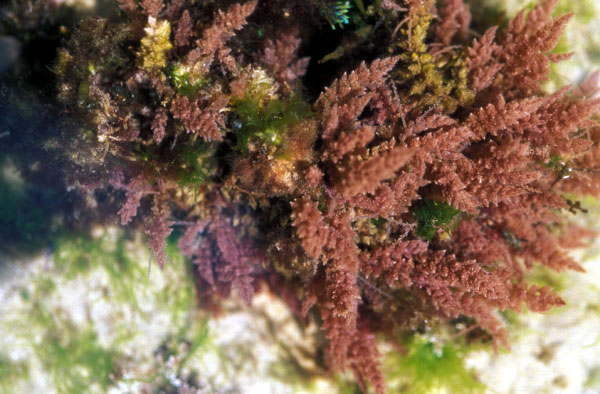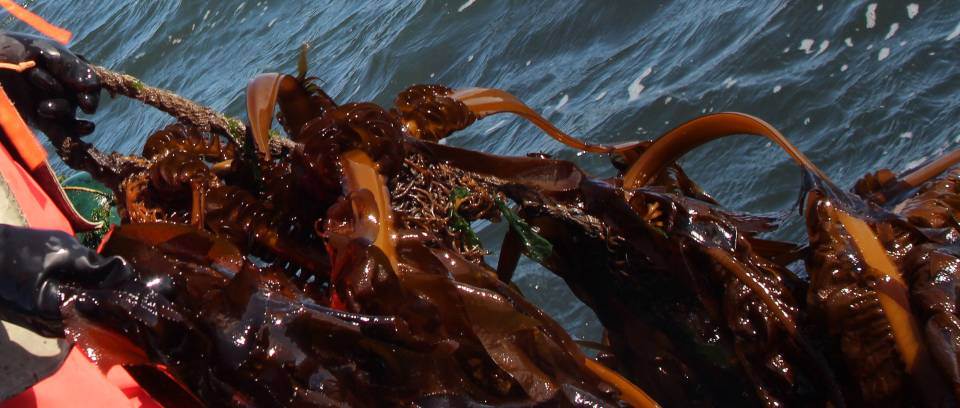The present study was to determine the effects of salinity on the growth and nutrient bioextraction abilities of Gracilaria and Ulva species, and to determine if these seaweeds can be used for nutrient bioextraction under hypo- and / or hyperosmotic conditions. Two Gracilaria species, G. chorda and G. vermiculophylla, and two Ulva species, U. prolifera and U. compressa, were cultured at various salinity conditions (5, 10, 15, 20, 30, 40, and 50 psu) for 3 weeks. Results showed that the growth rates, nutrient uptake, tissue nutrient contents and nutrient removal were significantly affected by salinity and species. All four species were euryhaline with the highest growth rates at 20 psu. Among the four species, U. prolifera, U. compressa, and G. vermiculophylla showed potential to be used for nutrient bioextraction in estuaries and / or land-based fish farms due to their rapid growth, high nutrient uptake, high tissue carbon and nitrogen accumulation and removal capacities.
Digital library
-
-
Palmaria palmata was integrated with Atlantic halibut Hippoglossus hippoglossus on a commercial farm for one year starting in November, with a temperature range of 0.4 to 19.1°C. The seaweed was grown in nine plastic mesh cages (each 1.25 m3 volume) suspended in a concrete sump tank (46 m3) in each of three recirculating systems. Two tanks received effluent water from tanks stocked with halibut, and the third received ambient seawater serving as a control. Thalli were tumbled by continuous aeration, and held under a constant photoperiod of 16 : 8 (L : D). Palmaria stocking density was 2.95 kg m-3 initially, increasing to 9.85 kg m-3 after a year. Specific growth rate was highest from April to June (8.0 to 9.0°C),1.1% d-1 in the halibut effluent and 0.8% d-1 in the control, but declined to zero or less than zero above 14°C. Total tissue nitrogen of Palmaria in effluent water was 4.2 to 4.4% DW from January to October, whereas tissue N in the control system declined to 3.0-3.6% DW from April to October. Tissue carbon was independent of seawater source at 39.9% DW. Estimated tank space required by Palmaria for 50% removal of the nitrogen excreted by 100 t of halibut during winter is about 29,000 to 38,000 m2, ten times the area required for halibut culture. Fifty percent removal of carbon from the same system requires 7,200 to 9,800 m2 cultivation area. Integration of P. palmata with Atlantic halibut is feasible below 10°C, but is impractical during summer months due to disintegration of thalli associated with reproductive maturation.
-
Chlorophyll-a, phycoerythrin, phycocyanin and allophycocyanin of the red alga, Gracilaria edulis, cultured in outdoor tanks under natural light at different depths were estimated. Crop growth rate and pigment contents in relation to varjdng light intensities (depth) were observed. An inverse relationship between pigment content and the light intensity was noted. But growth rate was more at higher light intensities.
-
Light emitting diode (LED) technology has significant potential advantages over other light sources in algal aquaculture. This study investigated LEDs as light sources for the culture of Gracilaria tikvahiae. We cultured a wild-type and a green mutant strain of G. tikvahiae, comparing growth rate and tissue chlorophyll a, total carotenoids, and phycobiliprotein concentrations under high output cool white fluorescent, pure primary color LED, and mixed LED lighting. Under monochromatic light, the growth rates under high output cool white fluorescent lighting were significantly higher than rates under pure LED light (all three colors for wild strain and green and blue for green mutant). However, when pure color LED lighting was mixed (50%/50%), the red + green (wild-type strain and green mutant) and the green + blue LED combinations (wild-type only) showed growth rates similar to those under high output cool white fluorescent lighting. In the trichromatic experiment, growth of the wild-type strain under mixed three-color (40%/40%/20%) LED light was indistinguishable from those of the fluorescent control lighting. Chlorophyll a and carotenoid concentrations of Gracilaria grown in the dichromatic light experiment were 55% and 74% higher, respectively, under red + blue LED lighting than under the other light treatments. The wild-type strain of G. tikvahiae possessed significantly greater concentrations of chlorophyll a, and phycoerythrin than did the green mutant, while green mutant thalli had higher phycocyanin levels. With rising LED efficiency and energy savings, LEDs will be an increasingly better choice for indoor seaweed cultivation, especially if control of pigment production and morphogenesis by selective use of particular wavelengths is desirable.
-
Two new guaiane sesquiterpene derivatives, guai-2-en-10ά-ol(1) and guai-2-en-10ά-methanol(2) were chromatographically purified as major constituents of the CHCl3/CH3OH
-
Three species of marine brown macroalgae (seaweeds), Myagropsis myagroides, Sargassum henslowianum and S. siliquastrum collected from Tung Ping Chau, Hong Kong were studied for their curative effects on hepatotoxicity caused by carbon tetrachloride (CCl4) in male Sprague-Dawley rats. A single suitable oral dose of 1.25 ml kg−1 of 20% CCl4 was used as a model hepatotoxin to produce significantly elevated levels of serum glutamic pyruvic transaminase (SGPT) and glutamic oxaloacetic transaminase (SGOT). Gavage oral administration of 300 mg kg−1 of methanol crude extract from S. siliquastrum 6 h post-treatment of CCl4 significantly reduced the CCl4-induced acute elevation in the levels of SGPT and SGOT in rats. Similar results, though at a less effective level, were achieved for extracts fromS. henslowianum and M. myagroides. These results indicate that these seaweeds may contain some active principles in their methanol extracts which acted as an antidote against the hepatotoxicity induced by CCl4. Further investigation is necessary to clarify and characterize the active component(s) in the extracts.
-
The search of sustainable and environmentally friendly alternatives to obtain compounds for different industrial sectors has grown exponentially. Following the principles of biorefinery and circular bioeconomy, processes in which the use of natural resources such as macroalgae biomass is prioritized are required. This review focuses on a description of the relevance, application and engineering platforms of hydrothermal systems and the operational conditions depending on the target as an innovative technology and bio-based solution for macroalgae fractionation in order to recover profitable products for industries and investors. In this sense, hydrothermal treatments represent a promising alternative for obtaining different high value-added compounds from this biomass; since, the different variations in terms of operating conditions, gives great versatility to this technology compared to other types of processing, allowing it to be adapted depending on the objective, whether it is working under sub/super critical conditions, thus expanding its field of application.
-
Coastal environments are prone to nutrient contamination as a result of excessive use of fertilizers in paddy agriculture on the land. To detect nutrient increases in coastal areas, researchers have used hyperspectral reflectance response to examine some coastal plants, which have proved to be effective as bioindicators. In this study, field hyperspectral technique was evaluated as a tool to detect nutrient concentrations in two coastal plants, i.e., seagrass (Enhalus acoroides) and brown algae (Sargassum sp.), taken from Banten Bay Indonesia, at laboratory scale. Although our initial experiments are still too few in elucidating an accurate relationship of nutrients and spectral signature, we are pleased to communicate that there is scientific evidence that hyperspectral measurement can be used to detect nutrient concentrations in coastal vegetation. Two types of fertilizers—urea, which contains 46% nitrogen, and triple super phosphate (TSP), which contains 14–20% soluble P2O5, commonly used by the local paddy farmers—were applied to both coastal plants in the aquarium experiment. The results of factorial analysis of variance (ANOVA) tests and pigmentrelated indices have proved that some significant differences exist in several wavelengths in response to the fertilizer treatments. This study revealed that brown algae were more sensitive to the same amount of fertilizer applied than seagrass.
-
Optimum levels of alkali/acid and thermal manipulations during extraction of agar were determined to increase the yield and quality of agar from red seaweed Gracilaria edulis (Gmelin) Silva. Pre-soaking of dry weeds in water for 2 h increased the yield by 11.44%, but did not improve the gel strength. Pre-soaking for 12 h increased gel strength and melting temperature considerably, but not the yield. Pre-soaking of dry weeds in 1.ON NaOH resulted in gel strength of 135 g.cm -2. Pre-soaking of dried weeds with 0.5N and 1.ON HCl even at higher temperature showed improvement neither in yield nor in the quality of agar and also resulted in hydrolysis of agar. Pretreatment at 2.0 - 3.0 N NaOH at 80°C for 1 hour to pre-soaked G.edulis for 11 h in water proved to be the most ideal and optimum extraction procedure to obtain higher yield (14.16%), maximum gel strength (291g.cm -2 ), lowest sulphate (0.732%) and highest melting point (99°C) of agar.
-
Two experiments were performed in the Bekaa plain in Lebanon to evaluate the feasibility of integrating aquaculture with established agriculture production in order to increase water productivity. Both experiments consisted of four plant management treatments: 1) Aquaculture effluent irrigation and no fertilizer; 2) aquaculture effluent irrigation and inorganic fertilizer; 3) well water irrigation and no fertilization; and 4) well water irrigation with inorganic fertilizer. In the first experiment, tilapia growth and radish production using aquaculture effluent were evaluated. All fish survived and grew, and radish production was improved by irrigating with aquaculture effluent. In the second experiment, maize (Zea mays) in large plots was irrigated with aquaculture effluent. Irrigation with effluent water improved maize production and improved soil nitrogen availability. In both experiments, fish production improved water value index and water use efficiency. Results suggest that aquaculture effluent can supplant inorganic fertilizers and could actually yield better crop production.





